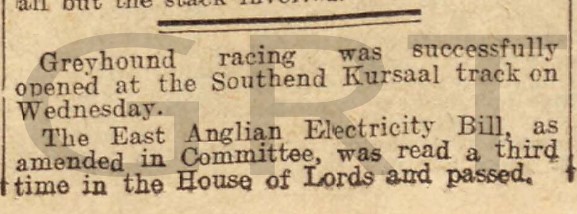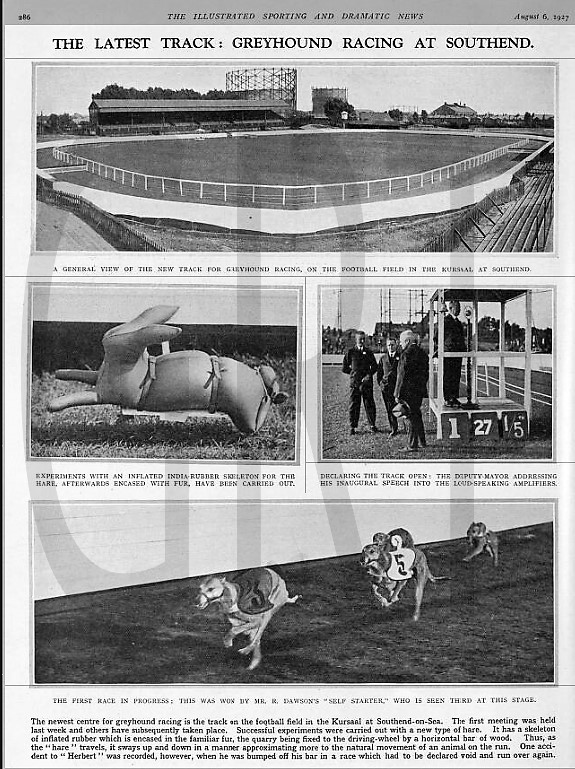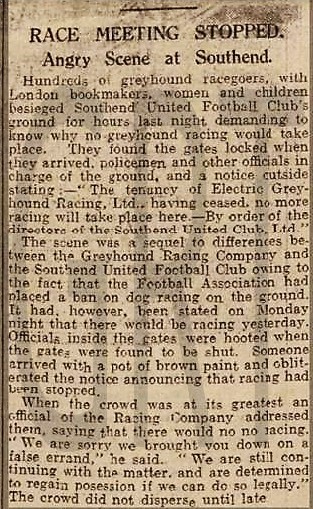Marine Park, Kursaal Amusement Grounds, Kursaal, Southend-on-Sea, Essex.
POSTCODE———————————-SS1 2JD
LOCATED————————————About half a mile east of Southend Pier.
ORIGINAL SITE—————————–A cricket an football pitches.
DATE CONSTRUCTED——————–The Amusement park was constructed just after the First World War.
DATE VENUE OPENED——————-1919 being the home to Southend United Football Club.
Meaning other sports may have taken place prior to the arrival of Greyhound Racing.
FIRST MEETING—————————–July 27th 1927.
Greyhound Racing only.
LICENSED OR INDEPENDENT———-Independent
All venues covered would have to be licensed with the government, licensed suggested in this section would refer to tracks operating under NGRC Rules.
INSIDE OR OUTSIDE HARE TYPE——Outside.
Please note that the Electric Hare suggested is only a guidance and would have been in operation for a certain amount of time at this venue. Although it is not necessarily guaranteed that it was operational all the time, as other types of lure may have been used and updated as time progressed.
DISTANCES———————————–500 yards.
Please note that most racing venues distances had become varied throughout the years, the ones given above were at once point set and offers only a guidance to the track size.
CIRCUMFERENCE—————————Don’t know.
Please note that alterations at most racing venues throughout its existence would see that the circumference of the track would vary, the one shown above offers only a guidance to the track size.
BIG RACE NAMES—————————Nothing known of.
STADIUM SHARED WITH——————Southend United used the venue between 1919-34.
LAST MEETING——————————-July 9th 1928.(Two meetings held)
Greyhound Racing only.
STADIUM CLOSURE DATE—————-Football ceased during 1934.
Meaning other sports may have taken place after Greyhound Racing had ceased.
STADIUM DEMOLITION——————-Most of the football stadium had been demolished by 1936 to make way for a scenic Railway, but the main stand lasted until the 1950’s before that was demolished.
BUILT ON SITE——————————-The Kursaal grounds are now covered by housing built during the 1970’s, on Prospect Close and a Family Centre Nursery, next to Kursaal Fairground site near the seafront.
In some cases, structure’s that originally covered the venue after the stadium had been demolished, may have been themselves demolished too, so the one described is more likely to be the one which now presently covers the site.
EVIDENCE LEFT TODAY——————-Nothing known of.
FURTHER COMMENTS——————–None











The Essex seaside resort of Southend-on-Sea adds to the list of towns that became home to more than one greyhound venue, albeit at different periods of time. With the Grainger Road track becoming the main feature of Southend’s greyhound racing history, it is these paragraphs that describes its first encounters of the sport in the town at its first location.
The track was known as the Kursaal Track, located about half a mile east of Southend Pier just set back away from the sea front. During the 1890’s, a sports field began to develop close the sea front, large enough to hold a cricket pitch and a small football pitch, and became known as Marine Park. The football pitch became the home to a number of amateur clubs who came and went before the enclosed ground had been left unoccupied at the end of the First World War. But in 1901 Marine Park became surrounded by a huge amusement park that stretched inland from the resorts esplanade, and became known as the Kursaal Grounds, and became one of the first amusement parks to be purposely built in the world.
In 1919 Marine Park became the new home to Southend United Football Club, who at the time played under amateur status, but their ambitions had seen them develop the ground by building two new stands, and constructing terracing behind each goal, which added up to Marine Park of having a crowd capacity of around 23,000. The football club was now in a position to be accepted in to the newly formed Third Division South. Success lasted only briefly, as the great depression of the late 1920’s was beginning to be felt with low attendances figuring at home matches, and left the football club looking for new ideas to increase income.
Although greyhound racing was virtually new on the scene at the time, an approach from a greyhound company to stage meetings was accepted. Once the track had been laid around the perimeter of the football pitch, a meeting was arranged for the Wednesday the 27th of July 1927, seeing the event becoming an instant success. A crowd of 5,000 would see a greyhound called Self Starter win the first event over 500 yards.
Further meetings were arranged without any serious problems, but the introduction of Sunday race meetings did not go ahead without controversy from local churches. But further and more serious objections began to filter through before the first year of greyhound racing was up, this time it was from the Football League, who had ordered the banning of the sport at all English football league grounds.
With two meetings having been staged on Monday the 9th of July 1928, the following evening had witnessed expectant patrons stranded outside the stadium due to the turnstiles having been locked, and it soon became clear that something wasn’t right. The football clubs officials who were present began to receive abuse once the angry crowd had read the notice pinned to the exit gates informing racegoers that there would be no greyhound racing at the venue from now on. The Football League Officials warned that if Southend United Football Club failed to impose the ban, then the football club would be instantly expelled from the Football League, leaving the club no alternative other than to comply with their decision. It was on these orders that the greyhound company began to look elsewhere to promote their venture, before eventually transferring all their equipment to the newly prepared Stanley track in Liverpool.
Southend United continued to host league matches at Marine Park for the next six seasons, but their troubles continued after massive rent increases at Marine Park forced them to look elsewhere to play. Within months the football club moved in as tenants at the newly constructed greyhound track at Grainger Road, before eventually moving on to a new home of their own in 1955.
By 1936 Marine Park had been transformed into a scenic railway, although the main stand remained derelict right up until the 1950’s, before that too was demolished. The Kursaal Grounds continued to operate as an amusement park up until the late 1960’s, before the site was sold to the council for redevelopment.
A new housing estate was constructed during the 1970’s on the site, totally obscuring any evidence of the sporting past, with the foundations of Marine Park being pinpointed by houses on Prospect Close, and the nearby family centre and nursery.
A programme, photograph or even memorabilia for this track is required for this page, if you can help please contact me.

Recent Comments